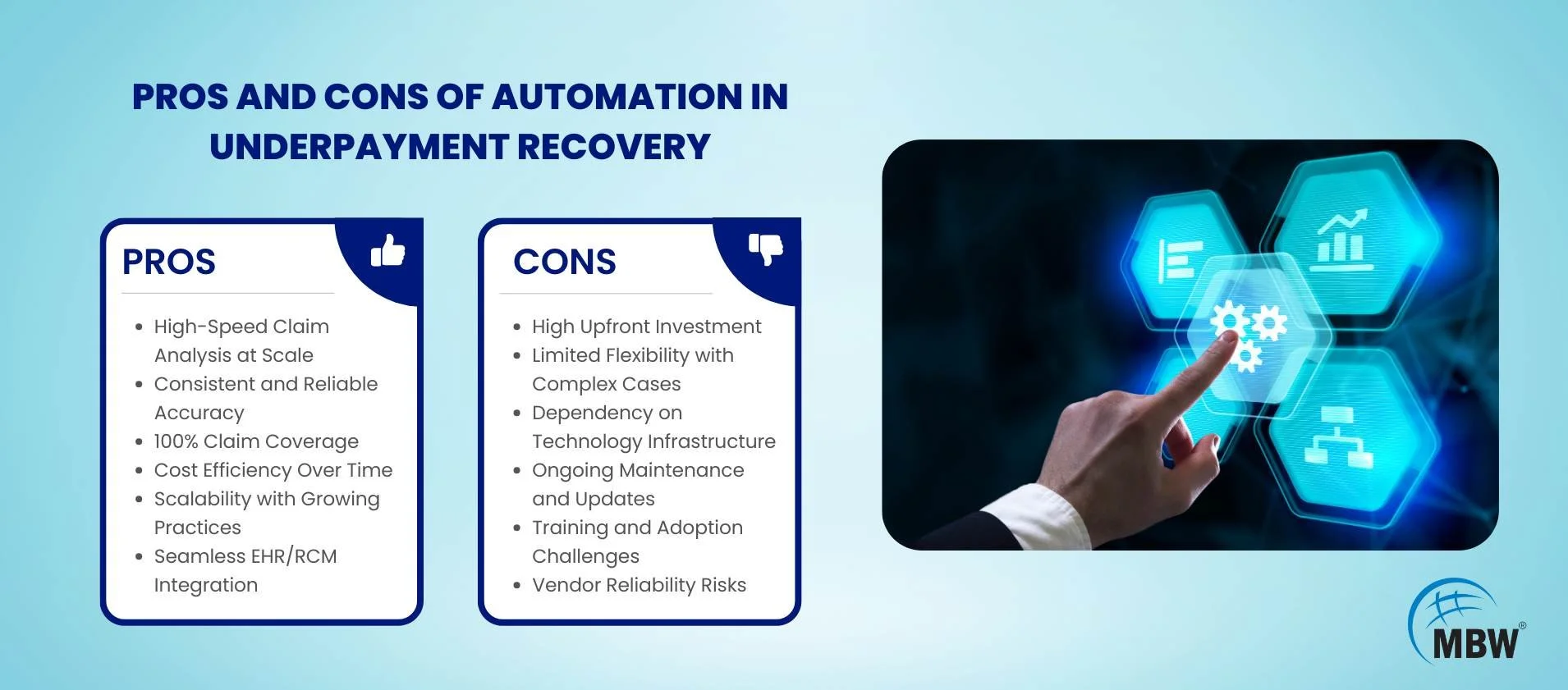Automation vs Manual Review: Choosing the Right Underpayment Strategy
Underpayments are a major problem in healthcare, silently siphoning away revenue and creating significant financial strain for practices. But how do you stop this hidden leak? The answer often lies in choosing the right strategy: should you rely on meticulous manual review or embrace the efficiency of automated software?
The choice between these two approaches isn’t always clear, as each has its own set of pros and cons. The best strategy for your practice depends on its size, claim volume, and unique billing challenges. This post will compare automated and manual underpayment recovery to help you determine the best path forward.
Table of Contents
The Manual Review Approach: The Human Touch
For many years, underpayment recovery was a hands-on, labor-intensive process. A billing specialist would manually compare the reimbursement on each Explanation of Benefits (EOB) against the practice’s fee schedule and payer contract.
Pros of Manual Review:
High Accuracy for Nuanced Cases: Experienced human reviewers can spot subtle underpayment issues that automated systems might miss. They can identify complex bundling rules, unique modifiers, or one-off contractual terms that require a deep understanding of the payer’s policy.
Root Cause Analysis: A dedicated billing specialist can not only find an underpayment but also identify the why behind it. This allows the practice to address recurring issues with a specific payer or coding pattern.
Tailored Appeals: Humans can craft customized appeal letters that directly quote contracts and explain exceptions, strengthening recovery efforts.
Cons of Manual Review:
Time-Consuming and Inefficient: The sheer volume of claims makes manual review slow and costly. Many underpayments inevitably slip through the cracks.
High Labor Costs: Skilled, well-trained billing staff are expensive—and their time is limited.
Potential for Human Error: Fatigue, distractions, and high claim volumes increase the risk of mistakes.
The Automated Approach: Speed and Scale
Technology has revolutionized the revenue cycle. Automated underpayment recovery software uses artificial intelligence (AI) and machine learning to compare received payments against contracted rates, identifying discrepancies at scale.
Pros of Automation:
Unmatched Efficiency: Automated systems can review thousands of claims in minutes. This enables a practice to audit 100% of its claims instead of sampling.
Scalability: As your practice grows, automation scales with you—no need to hire a team of billers to keep up.
Data-Driven Insights: Automation reveals payer patterns and systemic issues, providing leverage in contract negotiations. For example, it may show that a specific payer consistently underpays a certain CPT code.
Cons of Automation:
Can Miss Nuances: Systems are only as good as the rules behind them. Complex payer quirks or unusual contract terms may fall through the cracks.
Upfront Cost & Implementation: New software requires investment, staff training, and integration with your billing system.
Ongoing Oversight Needed: Human review is still required for exceptions, validation, and appeals.
If you are interested to read more about automation, please have a look at this blog on ‘‘automating patient eligibility to reduce claim denials’’.
Choosing the Right Strategy
The best solution is rarely all-or-nothing. Most practices succeed with a hybrid model: automation flags potential underpayments at scale, and billing specialists perform targeted manual reviews on complex or high-value cases.
For Small Practices: A diligent billing team may handle underpayments effectively through manual review. The cost of full-scale automation may not be justified.
For Large Practices/Systems: With high claim volumes, automation is essential. Without it, too much revenue slips away.
For Most Practices: A hybrid approach offers the best of both worlds—efficiency from automation and accuracy from human expertise. To explore how manual and automated methods complement each other, read this insightful article.
Conclusion: A Strategic Approach to Recovery
Underpayment recovery isn’t about being aggressive; it’s about being diligent and strategic. By understanding the strengths and weaknesses of manual vs. automated approaches—and adopting a hybrid model where appropriate—you can ensure your practice gets paid every dollar earned.
At MBW RCM, we help practices design underpayment recovery strategies tailored to their size, claim volume, and financial goals. Whether you need to implement revenue cycle automation, refine manual processes, or build a hybrid model, we can help.
Contact MBW RCM today for an expert review of your billing process and a strategic plan to recover underpayments efficiently.


